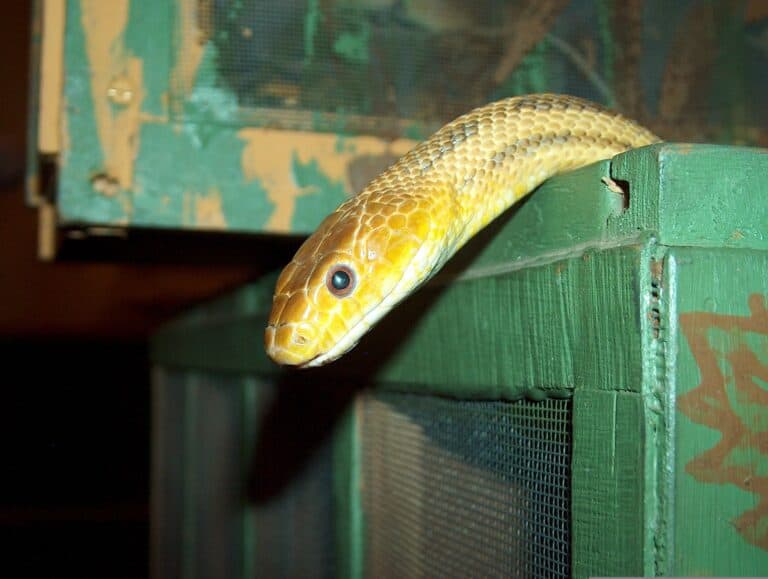[ad_1]
If you are afraid of snakes, I have bad news for you. There is no shortage of snake species on every, single continent on Earth except Antarctica.

The good news is that most snakes are completely harmless to people. The bad news is that some are downright deadly.
There is no immediately telling characteristic that will inform you whether or not a snake is poisonous, but often times in nature we see bright, vivid colors associated with dangerous animals.
How about black and yellow snakes? Are they poisonous?
It depends. Some black and yellow snakes like the yellow rat snake are completely harmless. Others, like the yellow-bellied sea snake, are deadly.
Unfortunately, there is no easy mnemonic or other trick that will always help you positively identify a black and yellow snake as harmless or dangerous.
Unless you are quite skilled and experienced with identifying snakes, you should make it a point to never approach any wild snake, and especially a black and yellow one.
We’ll talk more about black and yellow snakes and the possible threat they represent in the rest of this article.
What Do Black and Yellow Snakes Look Like?
Black and yellow snakes actually have quite a bit of variation depending on the species and the subspecies.
Some might be a glossy, smooth black color with tight, thin and evenly spaced yellow bands along the length of their body. Others might be a dusky charcoal black with a single yellow collar around their neck.
Still others might be a model or varying shades of black with a lemon or banana yellow belly.
Even in this seemingly simple color scheme there is a shocking amount of variation to be found on Earth.
Some may be very small, others might be impressively, frighteningly large. It all just depends.
Are Black and Yellow Snakes Venomous?
They might be, or they might not be. It depends upon the species. Some black and yellow snakes like the common king snake are entirely harmless to people.
Others, like the aforementioned yellow-bellied sea snake are extremely venomous.
In the case of this latter snake, it injects a potent cocktail of multiple neurotoxins and isotoxins that will rapidly incapacitate prey at sea or on land.
Conversely, if the common kingsnake were to bite you, assuming you could get this relatively docile snake to bite, you might have small lacerations or scratches from its tiny teeth.
Where are Black and Yellow Snakes Found?
Black and yellow snakes are found all around the world in many regions, both on land and at sea.
How Likely are These Snakes to Bite?
Once again, there is no easy answer when it comes to the bite tendencies of these snakes based on color alone. There are simply too many snakes that are black and yellow to easily categorize.
However, most snakes are quite content to be left well alone by people, and as a rule they will try to escape, avoid or hide from humans and other large animals that might just as easily kill them by accidentally stepping on them.
Most of these snakes will give obvious warnings of their presence, conspicuous defensive displays and other behavior that is designed to head off or avoid confrontation.
However, a few snakes tend to lead with their fangs first and ask questions later, relying upon venom or sheer physical ferocity to carry the day.
Does Their Bite Hurt?
Once again, it is entirely dependent upon the species and the size of the snake. A small garter snake will not hurt at all if it bites you, likely.
If an inland taipan bites you you’ll experience prolonged, utterly debilitating, excruciating pain before likely dying the next day.
Are Black and Yellow Snakes Aggressive Toward People?
Statistically, most black and yellow snakes are not aggressive toward people.
As mentioned above, your average black and yellow snake will want to avoid people or convince people to leave it alone by engaging in defensive display behaviors.
However, some black and yellow snakes might vigorously defend themselves when approached, cornered or harassed.
For clarity, you cannot make any judgment call on the threat, aggressiveness or any other pertinent details of a snake based on its coloration alone unless you are able to positively identify the species.
Will Black and Yellow Snakes Bother Animals?
Perhaps. Most black and yellow snakes eat small prey, eggs and other creatures they are capable of overpowering and killing one way or another.
Young chickens or ducks along with eggs are at risk of being eaten by many kinds of snakes, including several yellow and black ones. Most larger animals and livestock don’t have anything to fear.
However, in the case of venomous species overenthusiastic pets, particularly dogs and cats, might well be bitten when approaching a snake out of interest or protectiveness.
Similarly, larger animals might be bitten if they accidentally step on or step to near such a snake, and in the cases of all other species might be panicked by the sudden appearance of a snake, sending them into a stampede.
Should You Kill Black and Yellow Snakes?
Generally no, and there’s usually no reason to kill a snake. Most will be entirely content to get away from human activity and go on with their lives.
However, if there is a risk of a bad outcome or danger from a snake that is acting aggressively and will not retreat, or if retreat is impossible, you should not hesitate to kill it in order to protect life.
[ad_2]
Source link
Get more stuff like this
in your inbox
Don't Be Left Unprepared
Thank you for subscribing.
Something went wrong.





